Analyzing Training Impact on Manager Performance in Retail Sector
VerifiedAdded on 2021/01/03
|17
|4759
|92
Report
AI Summary
This report provides a comprehensive analysis of the impact of training on manager performance within retail organizations, using Tesco as a case study. It begins with an introduction that highlights the significance of employee training and its role in enhancing skills and performance, setting the stage for a deeper exploration of the topic. The literature review examines various definitions of training and its impact on performance, drawing on insights from relevant research. The methodology section outlines the research approach, including the use of ontology and an inductive research approach, as well as data collection methods such as questionnaires and secondary data sources. The report explores the relationship between training and manager's performance, including factors that influence training effectiveness. The findings suggest that training programs positively affect employee motivation, commitment, and overall organizational performance. Finally, the conclusion summarizes the key findings and offers recommendations for improving training programs to enhance manager's performance and contribute to the organization's success. This report is designed to provide students with valuable insights into effective training practices in the retail sector.
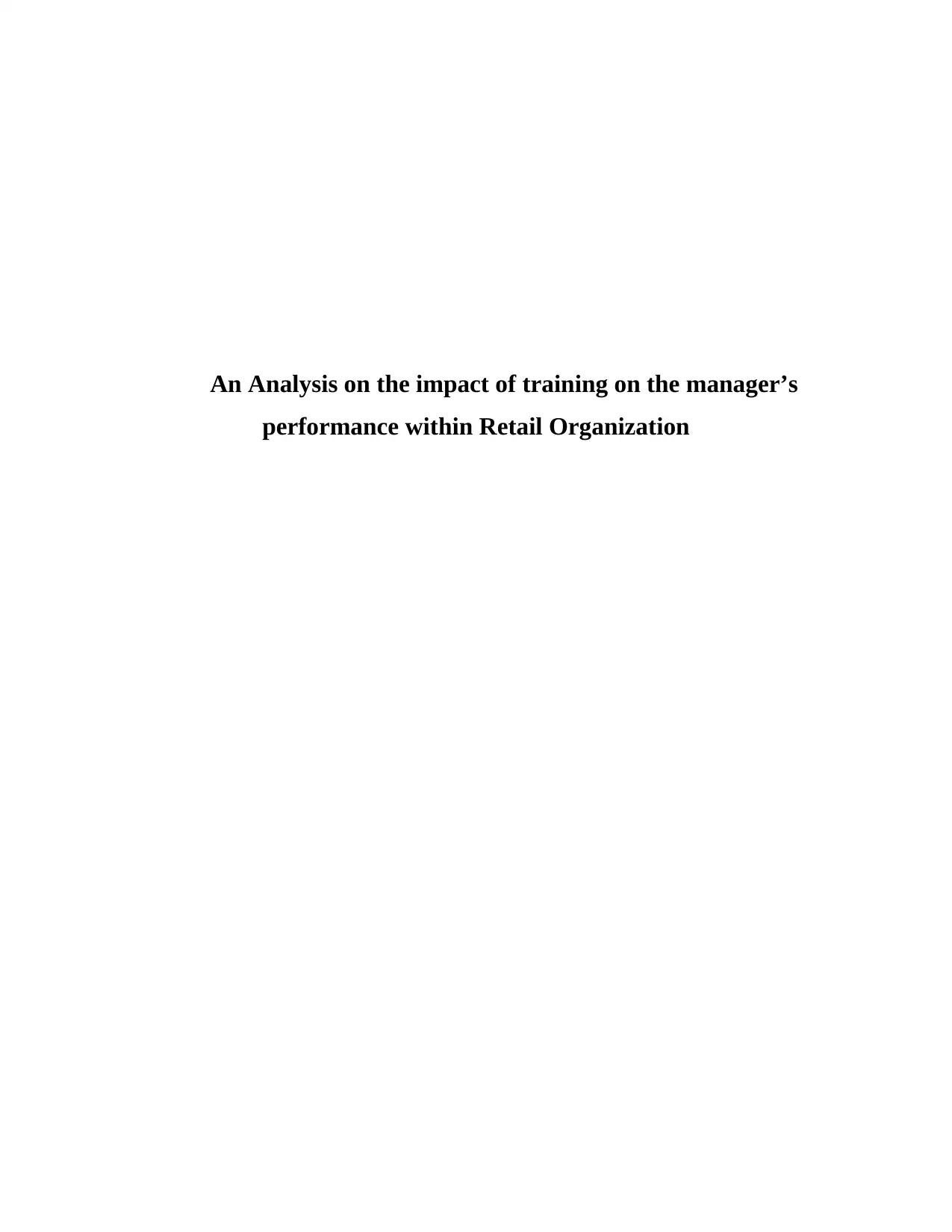
An Analysis on the impact of training on the manager’s
performance within Retail Organization
performance within Retail Organization
Paraphrase This Document
Need a fresh take? Get an instant paraphrase of this document with our AI Paraphraser
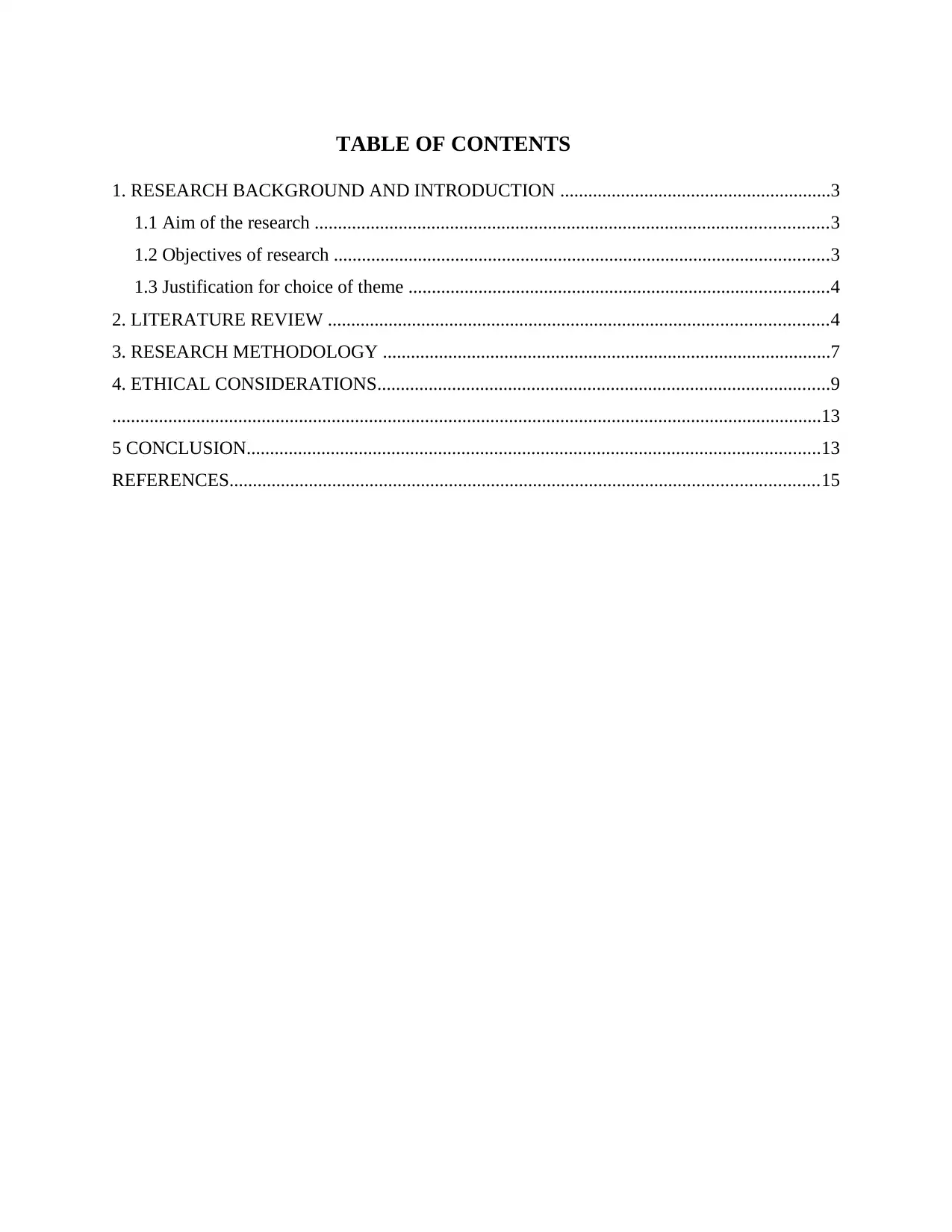
TABLE OF CONTENTS
1. RESEARCH BACKGROUND AND INTRODUCTION ..........................................................3
1.1 Aim of the research ..............................................................................................................3
1.2 Objectives of research ..........................................................................................................3
1.3 Justification for choice of theme ..........................................................................................4
2. LITERATURE REVIEW ...........................................................................................................4
3. RESEARCH METHODOLOGY ................................................................................................7
4. ETHICAL CONSIDERATIONS.................................................................................................9
........................................................................................................................................................13
5 CONCLUSION...........................................................................................................................13
REFERENCES..............................................................................................................................15
1. RESEARCH BACKGROUND AND INTRODUCTION ..........................................................3
1.1 Aim of the research ..............................................................................................................3
1.2 Objectives of research ..........................................................................................................3
1.3 Justification for choice of theme ..........................................................................................4
2. LITERATURE REVIEW ...........................................................................................................4
3. RESEARCH METHODOLOGY ................................................................................................7
4. ETHICAL CONSIDERATIONS.................................................................................................9
........................................................................................................................................................13
5 CONCLUSION...........................................................................................................................13
REFERENCES..............................................................................................................................15
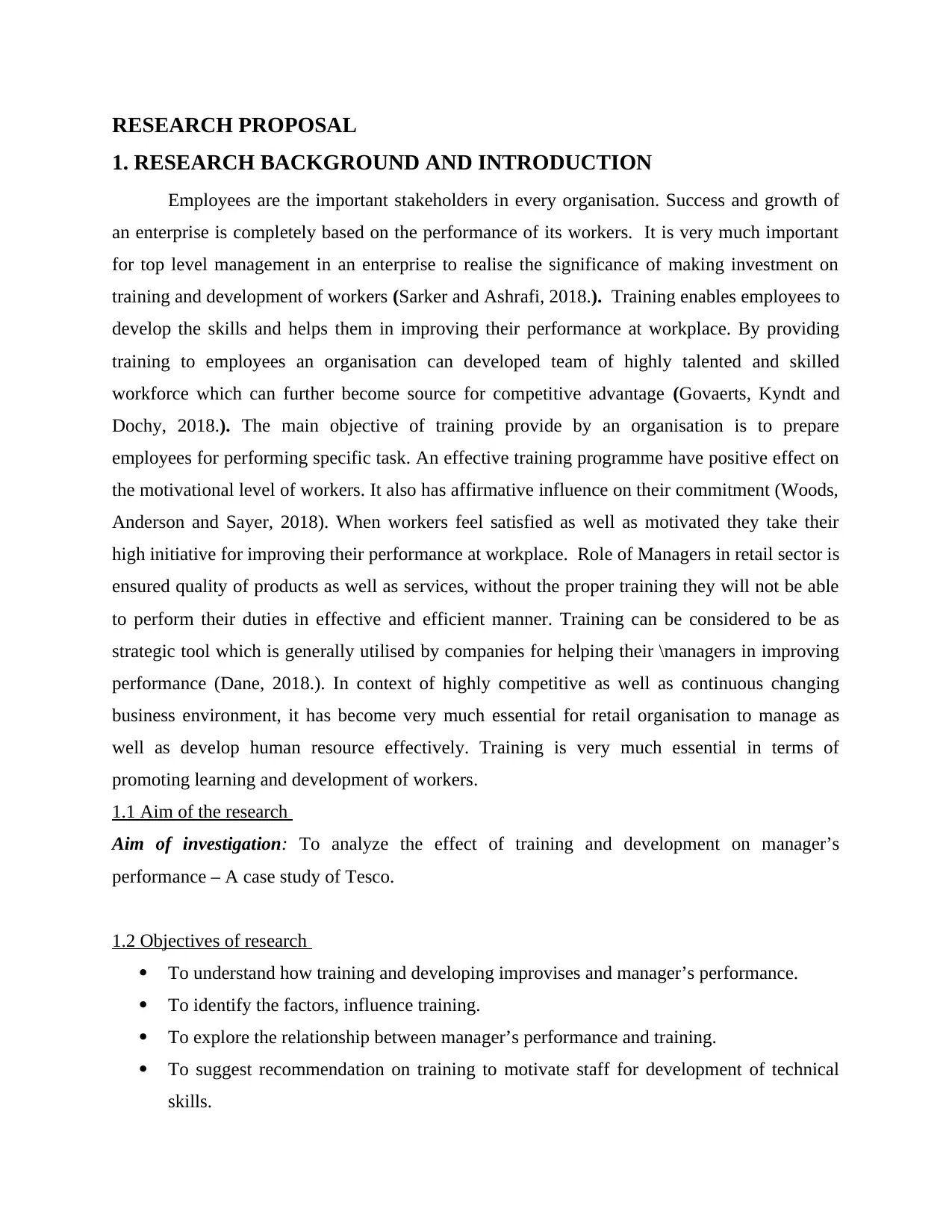
RESEARCH PROPOSAL
1. RESEARCH BACKGROUND AND INTRODUCTION
Employees are the important stakeholders in every organisation. Success and growth of
an enterprise is completely based on the performance of its workers. It is very much important
for top level management in an enterprise to realise the significance of making investment on
training and development of workers (Sarker and Ashrafi, 2018.). Training enables employees to
develop the skills and helps them in improving their performance at workplace. By providing
training to employees an organisation can developed team of highly talented and skilled
workforce which can further become source for competitive advantage (Govaerts, Kyndt and
Dochy, 2018.). The main objective of training provide by an organisation is to prepare
employees for performing specific task. An effective training programme have positive effect on
the motivational level of workers. It also has affirmative influence on their commitment (Woods,
Anderson and Sayer, 2018). When workers feel satisfied as well as motivated they take their
high initiative for improving their performance at workplace. Role of Managers in retail sector is
ensured quality of products as well as services, without the proper training they will not be able
to perform their duties in effective and efficient manner. Training can be considered to be as
strategic tool which is generally utilised by companies for helping their \managers in improving
performance (Dane, 2018.). In context of highly competitive as well as continuous changing
business environment, it has become very much essential for retail organisation to manage as
well as develop human resource effectively. Training is very much essential in terms of
promoting learning and development of workers.
1.1 Aim of the research
Aim of investigation: To analyze the effect of training and development on manager’s
performance – A case study of Tesco.
1.2 Objectives of research
To understand how training and developing improvises and manager’s performance.
To identify the factors, influence training.
To explore the relationship between manager’s performance and training.
To suggest recommendation on training to motivate staff for development of technical
skills.
1. RESEARCH BACKGROUND AND INTRODUCTION
Employees are the important stakeholders in every organisation. Success and growth of
an enterprise is completely based on the performance of its workers. It is very much important
for top level management in an enterprise to realise the significance of making investment on
training and development of workers (Sarker and Ashrafi, 2018.). Training enables employees to
develop the skills and helps them in improving their performance at workplace. By providing
training to employees an organisation can developed team of highly talented and skilled
workforce which can further become source for competitive advantage (Govaerts, Kyndt and
Dochy, 2018.). The main objective of training provide by an organisation is to prepare
employees for performing specific task. An effective training programme have positive effect on
the motivational level of workers. It also has affirmative influence on their commitment (Woods,
Anderson and Sayer, 2018). When workers feel satisfied as well as motivated they take their
high initiative for improving their performance at workplace. Role of Managers in retail sector is
ensured quality of products as well as services, without the proper training they will not be able
to perform their duties in effective and efficient manner. Training can be considered to be as
strategic tool which is generally utilised by companies for helping their \managers in improving
performance (Dane, 2018.). In context of highly competitive as well as continuous changing
business environment, it has become very much essential for retail organisation to manage as
well as develop human resource effectively. Training is very much essential in terms of
promoting learning and development of workers.
1.1 Aim of the research
Aim of investigation: To analyze the effect of training and development on manager’s
performance – A case study of Tesco.
1.2 Objectives of research
To understand how training and developing improvises and manager’s performance.
To identify the factors, influence training.
To explore the relationship between manager’s performance and training.
To suggest recommendation on training to motivate staff for development of technical
skills.
⊘ This is a preview!⊘
Do you want full access?
Subscribe today to unlock all pages.

Trusted by 1+ million students worldwide
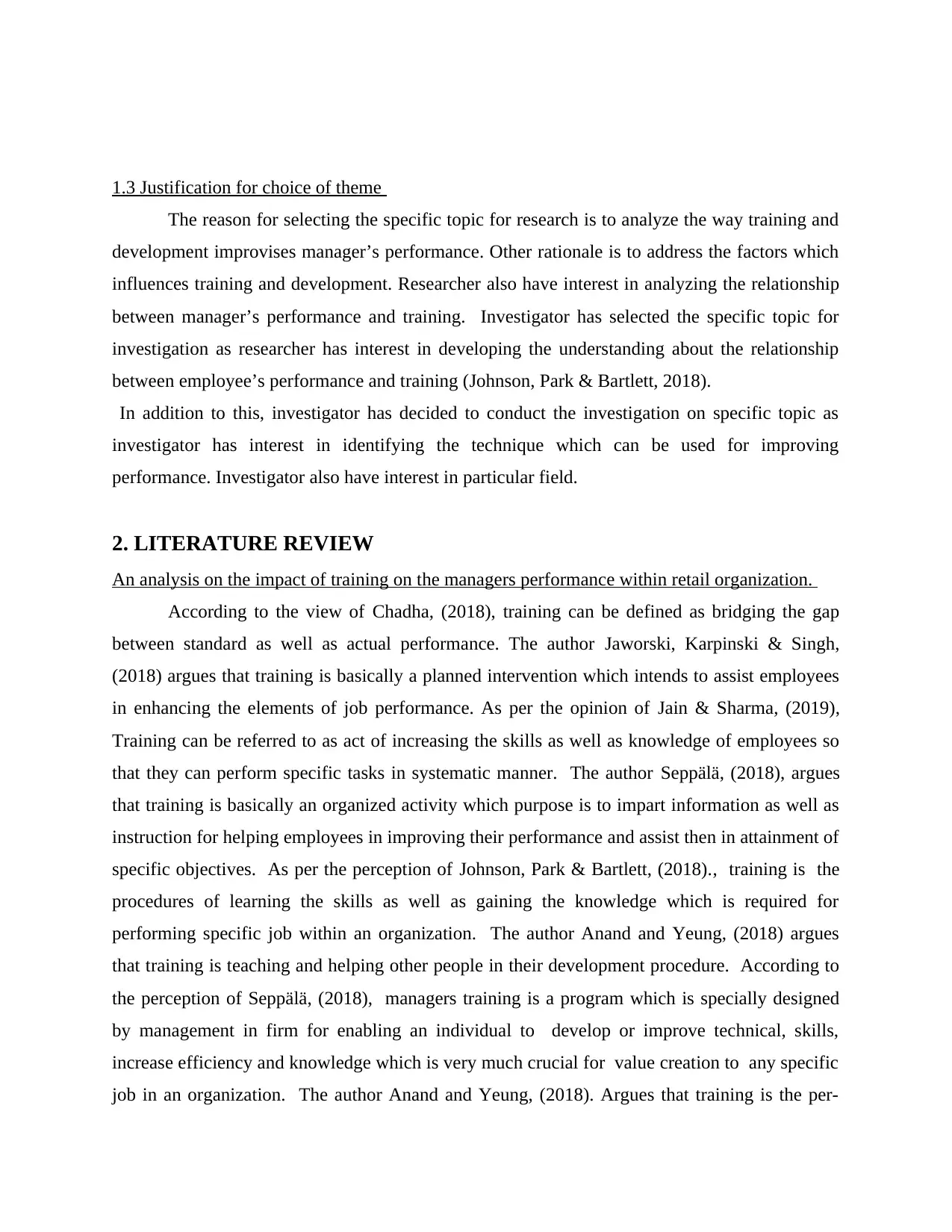
1.3 Justification for choice of theme
The reason for selecting the specific topic for research is to analyze the way training and
development improvises manager’s performance. Other rationale is to address the factors which
influences training and development. Researcher also have interest in analyzing the relationship
between manager’s performance and training. Investigator has selected the specific topic for
investigation as researcher has interest in developing the understanding about the relationship
between employee’s performance and training (Johnson, Park & Bartlett, 2018).
In addition to this, investigator has decided to conduct the investigation on specific topic as
investigator has interest in identifying the technique which can be used for improving
performance. Investigator also have interest in particular field.
2. LITERATURE REVIEW
An analysis on the impact of training on the managers performance within retail organization.
According to the view of Chadha, (2018), training can be defined as bridging the gap
between standard as well as actual performance. The author Jaworski, Karpinski & Singh,
(2018) argues that training is basically a planned intervention which intends to assist employees
in enhancing the elements of job performance. As per the opinion of Jain & Sharma, (2019),
Training can be referred to as act of increasing the skills as well as knowledge of employees so
that they can perform specific tasks in systematic manner. The author Seppälä, (2018), argues
that training is basically an organized activity which purpose is to impart information as well as
instruction for helping employees in improving their performance and assist then in attainment of
specific objectives. As per the perception of Johnson, Park & Bartlett, (2018)., training is the
procedures of learning the skills as well as gaining the knowledge which is required for
performing specific job within an organization. The author Anand and Yeung, (2018) argues
that training is teaching and helping other people in their development procedure. According to
the perception of Seppälä, (2018), managers training is a program which is specially designed
by management in firm for enabling an individual to develop or improve technical, skills,
increase efficiency and knowledge which is very much crucial for value creation to any specific
job in an organization. The author Anand and Yeung, (2018). Argues that training is the per-
The reason for selecting the specific topic for research is to analyze the way training and
development improvises manager’s performance. Other rationale is to address the factors which
influences training and development. Researcher also have interest in analyzing the relationship
between manager’s performance and training. Investigator has selected the specific topic for
investigation as researcher has interest in developing the understanding about the relationship
between employee’s performance and training (Johnson, Park & Bartlett, 2018).
In addition to this, investigator has decided to conduct the investigation on specific topic as
investigator has interest in identifying the technique which can be used for improving
performance. Investigator also have interest in particular field.
2. LITERATURE REVIEW
An analysis on the impact of training on the managers performance within retail organization.
According to the view of Chadha, (2018), training can be defined as bridging the gap
between standard as well as actual performance. The author Jaworski, Karpinski & Singh,
(2018) argues that training is basically a planned intervention which intends to assist employees
in enhancing the elements of job performance. As per the opinion of Jain & Sharma, (2019),
Training can be referred to as act of increasing the skills as well as knowledge of employees so
that they can perform specific tasks in systematic manner. The author Seppälä, (2018), argues
that training is basically an organized activity which purpose is to impart information as well as
instruction for helping employees in improving their performance and assist then in attainment of
specific objectives. As per the perception of Johnson, Park & Bartlett, (2018)., training is the
procedures of learning the skills as well as gaining the knowledge which is required for
performing specific job within an organization. The author Anand and Yeung, (2018) argues
that training is teaching and helping other people in their development procedure. According to
the perception of Seppälä, (2018), managers training is a program which is specially designed
by management in firm for enabling an individual to develop or improve technical, skills,
increase efficiency and knowledge which is very much crucial for value creation to any specific
job in an organization. The author Anand and Yeung, (2018). Argues that training is the per-
Paraphrase This Document
Need a fresh take? Get an instant paraphrase of this document with our AI Paraphraser
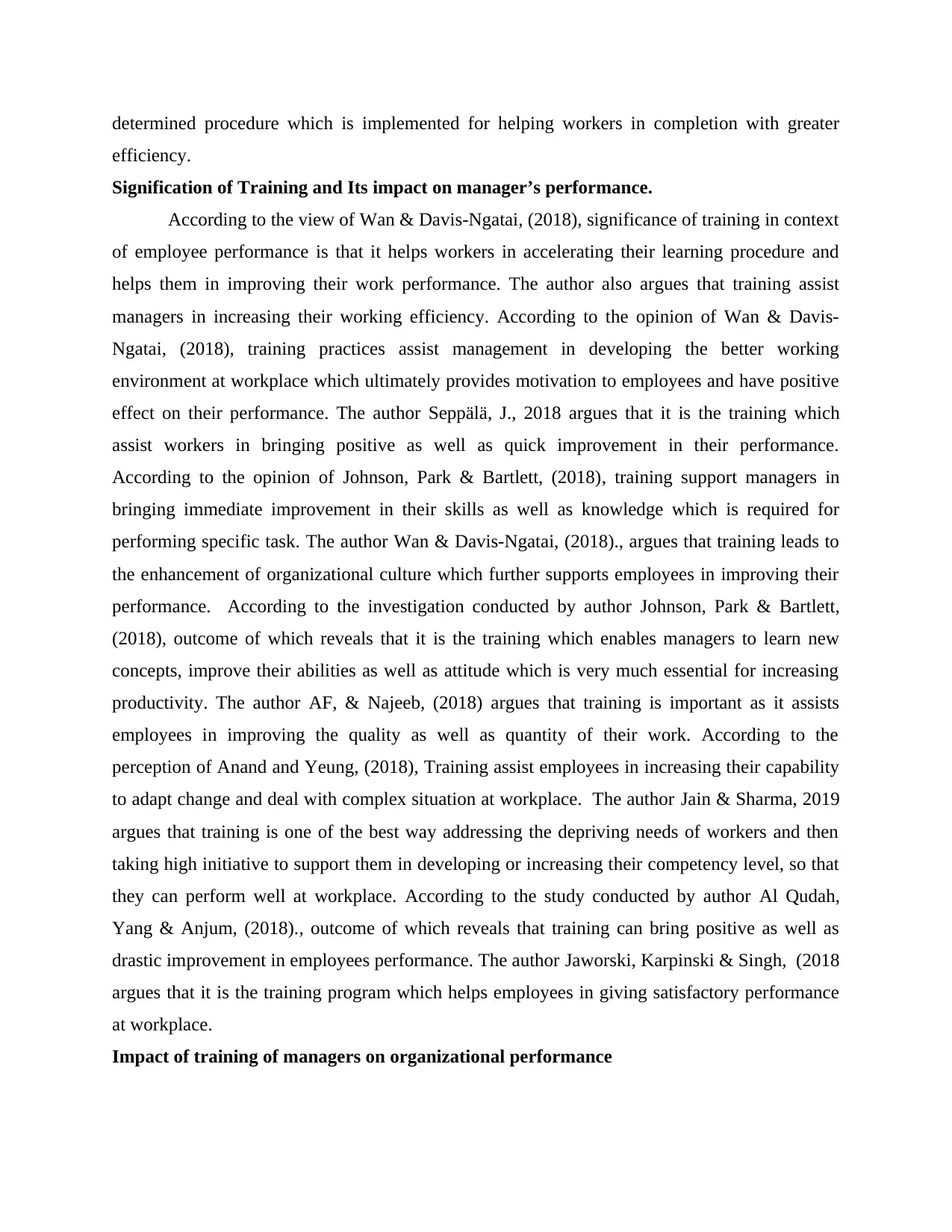
determined procedure which is implemented for helping workers in completion with greater
efficiency.
Signification of Training and Its impact on manager’s performance.
According to the view of Wan & Davis-Ngatai, (2018), significance of training in context
of employee performance is that it helps workers in accelerating their learning procedure and
helps them in improving their work performance. The author also argues that training assist
managers in increasing their working efficiency. According to the opinion of Wan & Davis-
Ngatai, (2018), training practices assist management in developing the better working
environment at workplace which ultimately provides motivation to employees and have positive
effect on their performance. The author Seppälä, J., 2018 argues that it is the training which
assist workers in bringing positive as well as quick improvement in their performance.
According to the opinion of Johnson, Park & Bartlett, (2018), training support managers in
bringing immediate improvement in their skills as well as knowledge which is required for
performing specific task. The author Wan & Davis-Ngatai, (2018)., argues that training leads to
the enhancement of organizational culture which further supports employees in improving their
performance. According to the investigation conducted by author Johnson, Park & Bartlett,
(2018), outcome of which reveals that it is the training which enables managers to learn new
concepts, improve their abilities as well as attitude which is very much essential for increasing
productivity. The author AF, & Najeeb, (2018) argues that training is important as it assists
employees in improving the quality as well as quantity of their work. According to the
perception of Anand and Yeung, (2018), Training assist employees in increasing their capability
to adapt change and deal with complex situation at workplace. The author Jain & Sharma, 2019
argues that training is one of the best way addressing the depriving needs of workers and then
taking high initiative to support them in developing or increasing their competency level, so that
they can perform well at workplace. According to the study conducted by author Al Qudah,
Yang & Anjum, (2018)., outcome of which reveals that training can bring positive as well as
drastic improvement in employees performance. The author Jaworski, Karpinski & Singh, (2018
argues that it is the training program which helps employees in giving satisfactory performance
at workplace.
Impact of training of managers on organizational performance
efficiency.
Signification of Training and Its impact on manager’s performance.
According to the view of Wan & Davis-Ngatai, (2018), significance of training in context
of employee performance is that it helps workers in accelerating their learning procedure and
helps them in improving their work performance. The author also argues that training assist
managers in increasing their working efficiency. According to the opinion of Wan & Davis-
Ngatai, (2018), training practices assist management in developing the better working
environment at workplace which ultimately provides motivation to employees and have positive
effect on their performance. The author Seppälä, J., 2018 argues that it is the training which
assist workers in bringing positive as well as quick improvement in their performance.
According to the opinion of Johnson, Park & Bartlett, (2018), training support managers in
bringing immediate improvement in their skills as well as knowledge which is required for
performing specific task. The author Wan & Davis-Ngatai, (2018)., argues that training leads to
the enhancement of organizational culture which further supports employees in improving their
performance. According to the investigation conducted by author Johnson, Park & Bartlett,
(2018), outcome of which reveals that it is the training which enables managers to learn new
concepts, improve their abilities as well as attitude which is very much essential for increasing
productivity. The author AF, & Najeeb, (2018) argues that training is important as it assists
employees in improving the quality as well as quantity of their work. According to the
perception of Anand and Yeung, (2018), Training assist employees in increasing their capability
to adapt change and deal with complex situation at workplace. The author Jain & Sharma, 2019
argues that training is one of the best way addressing the depriving needs of workers and then
taking high initiative to support them in developing or increasing their competency level, so that
they can perform well at workplace. According to the study conducted by author Al Qudah,
Yang & Anjum, (2018)., outcome of which reveals that training can bring positive as well as
drastic improvement in employees performance. The author Jaworski, Karpinski & Singh, (2018
argues that it is the training program which helps employees in giving satisfactory performance
at workplace.
Impact of training of managers on organizational performance
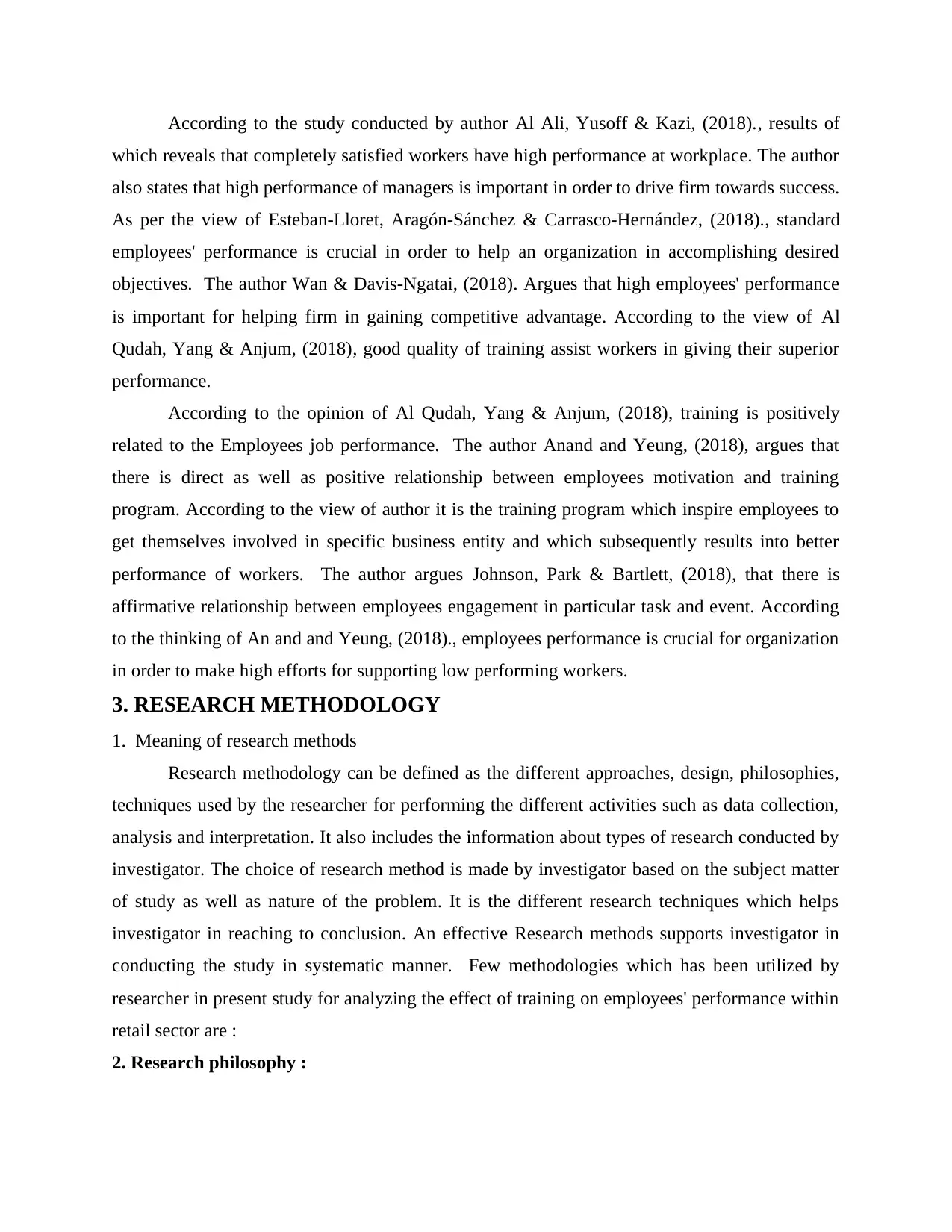
According to the study conducted by author Al Ali, Yusoff & Kazi, (2018)., results of
which reveals that completely satisfied workers have high performance at workplace. The author
also states that high performance of managers is important in order to drive firm towards success.
As per the view of Esteban-Lloret, Aragón-Sánchez & Carrasco-Hernández, (2018)., standard
employees' performance is crucial in order to help an organization in accomplishing desired
objectives. The author Wan & Davis-Ngatai, (2018). Argues that high employees' performance
is important for helping firm in gaining competitive advantage. According to the view of Al
Qudah, Yang & Anjum, (2018), good quality of training assist workers in giving their superior
performance.
According to the opinion of Al Qudah, Yang & Anjum, (2018), training is positively
related to the Employees job performance. The author Anand and Yeung, (2018), argues that
there is direct as well as positive relationship between employees motivation and training
program. According to the view of author it is the training program which inspire employees to
get themselves involved in specific business entity and which subsequently results into better
performance of workers. The author argues Johnson, Park & Bartlett, (2018), that there is
affirmative relationship between employees engagement in particular task and event. According
to the thinking of An and and Yeung, (2018)., employees performance is crucial for organization
in order to make high efforts for supporting low performing workers.
3. RESEARCH METHODOLOGY
1. Meaning of research methods
Research methodology can be defined as the different approaches, design, philosophies,
techniques used by the researcher for performing the different activities such as data collection,
analysis and interpretation. It also includes the information about types of research conducted by
investigator. The choice of research method is made by investigator based on the subject matter
of study as well as nature of the problem. It is the different research techniques which helps
investigator in reaching to conclusion. An effective Research methods supports investigator in
conducting the study in systematic manner. Few methodologies which has been utilized by
researcher in present study for analyzing the effect of training on employees' performance within
retail sector are :
2. Research philosophy :
which reveals that completely satisfied workers have high performance at workplace. The author
also states that high performance of managers is important in order to drive firm towards success.
As per the view of Esteban-Lloret, Aragón-Sánchez & Carrasco-Hernández, (2018)., standard
employees' performance is crucial in order to help an organization in accomplishing desired
objectives. The author Wan & Davis-Ngatai, (2018). Argues that high employees' performance
is important for helping firm in gaining competitive advantage. According to the view of Al
Qudah, Yang & Anjum, (2018), good quality of training assist workers in giving their superior
performance.
According to the opinion of Al Qudah, Yang & Anjum, (2018), training is positively
related to the Employees job performance. The author Anand and Yeung, (2018), argues that
there is direct as well as positive relationship between employees motivation and training
program. According to the view of author it is the training program which inspire employees to
get themselves involved in specific business entity and which subsequently results into better
performance of workers. The author argues Johnson, Park & Bartlett, (2018), that there is
affirmative relationship between employees engagement in particular task and event. According
to the thinking of An and and Yeung, (2018)., employees performance is crucial for organization
in order to make high efforts for supporting low performing workers.
3. RESEARCH METHODOLOGY
1. Meaning of research methods
Research methodology can be defined as the different approaches, design, philosophies,
techniques used by the researcher for performing the different activities such as data collection,
analysis and interpretation. It also includes the information about types of research conducted by
investigator. The choice of research method is made by investigator based on the subject matter
of study as well as nature of the problem. It is the different research techniques which helps
investigator in reaching to conclusion. An effective Research methods supports investigator in
conducting the study in systematic manner. Few methodologies which has been utilized by
researcher in present study for analyzing the effect of training on employees' performance within
retail sector are :
2. Research philosophy :
⊘ This is a preview!⊘
Do you want full access?
Subscribe today to unlock all pages.

Trusted by 1+ million students worldwide
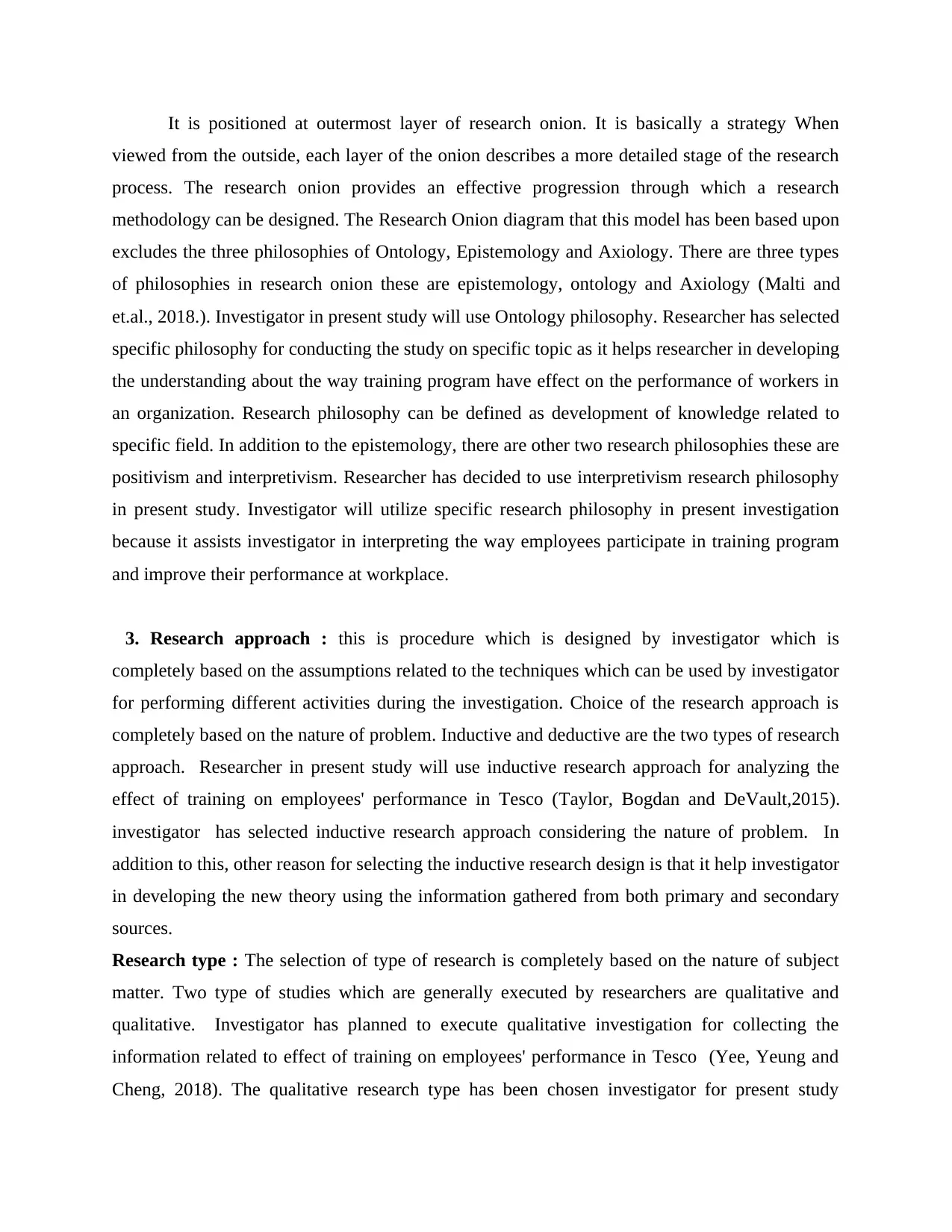
It is positioned at outermost layer of research onion. It is basically a strategy When
viewed from the outside, each layer of the onion describes a more detailed stage of the research
process. The research onion provides an effective progression through which a research
methodology can be designed. The Research Onion diagram that this model has been based upon
excludes the three philosophies of Ontology, Epistemology and Axiology. There are three types
of philosophies in research onion these are epistemology, ontology and Axiology (Malti and
et.al., 2018.). Investigator in present study will use Ontology philosophy. Researcher has selected
specific philosophy for conducting the study on specific topic as it helps researcher in developing
the understanding about the way training program have effect on the performance of workers in
an organization. Research philosophy can be defined as development of knowledge related to
specific field. In addition to the epistemology, there are other two research philosophies these are
positivism and interpretivism. Researcher has decided to use interpretivism research philosophy
in present study. Investigator will utilize specific research philosophy in present investigation
because it assists investigator in interpreting the way employees participate in training program
and improve their performance at workplace.
3. Research approach : this is procedure which is designed by investigator which is
completely based on the assumptions related to the techniques which can be used by investigator
for performing different activities during the investigation. Choice of the research approach is
completely based on the nature of problem. Inductive and deductive are the two types of research
approach. Researcher in present study will use inductive research approach for analyzing the
effect of training on employees' performance in Tesco (Taylor, Bogdan and DeVault,2015).
investigator has selected inductive research approach considering the nature of problem. In
addition to this, other reason for selecting the inductive research design is that it help investigator
in developing the new theory using the information gathered from both primary and secondary
sources.
Research type : The selection of type of research is completely based on the nature of subject
matter. Two type of studies which are generally executed by researchers are qualitative and
qualitative. Investigator has planned to execute qualitative investigation for collecting the
information related to effect of training on employees' performance in Tesco (Yee, Yeung and
Cheng, 2018). The qualitative research type has been chosen investigator for present study
viewed from the outside, each layer of the onion describes a more detailed stage of the research
process. The research onion provides an effective progression through which a research
methodology can be designed. The Research Onion diagram that this model has been based upon
excludes the three philosophies of Ontology, Epistemology and Axiology. There are three types
of philosophies in research onion these are epistemology, ontology and Axiology (Malti and
et.al., 2018.). Investigator in present study will use Ontology philosophy. Researcher has selected
specific philosophy for conducting the study on specific topic as it helps researcher in developing
the understanding about the way training program have effect on the performance of workers in
an organization. Research philosophy can be defined as development of knowledge related to
specific field. In addition to the epistemology, there are other two research philosophies these are
positivism and interpretivism. Researcher has decided to use interpretivism research philosophy
in present study. Investigator will utilize specific research philosophy in present investigation
because it assists investigator in interpreting the way employees participate in training program
and improve their performance at workplace.
3. Research approach : this is procedure which is designed by investigator which is
completely based on the assumptions related to the techniques which can be used by investigator
for performing different activities during the investigation. Choice of the research approach is
completely based on the nature of problem. Inductive and deductive are the two types of research
approach. Researcher in present study will use inductive research approach for analyzing the
effect of training on employees' performance in Tesco (Taylor, Bogdan and DeVault,2015).
investigator has selected inductive research approach considering the nature of problem. In
addition to this, other reason for selecting the inductive research design is that it help investigator
in developing the new theory using the information gathered from both primary and secondary
sources.
Research type : The selection of type of research is completely based on the nature of subject
matter. Two type of studies which are generally executed by researchers are qualitative and
qualitative. Investigator has planned to execute qualitative investigation for collecting the
information related to effect of training on employees' performance in Tesco (Yee, Yeung and
Cheng, 2018). The qualitative research type has been chosen investigator for present study
Paraphrase This Document
Need a fresh take? Get an instant paraphrase of this document with our AI Paraphraser
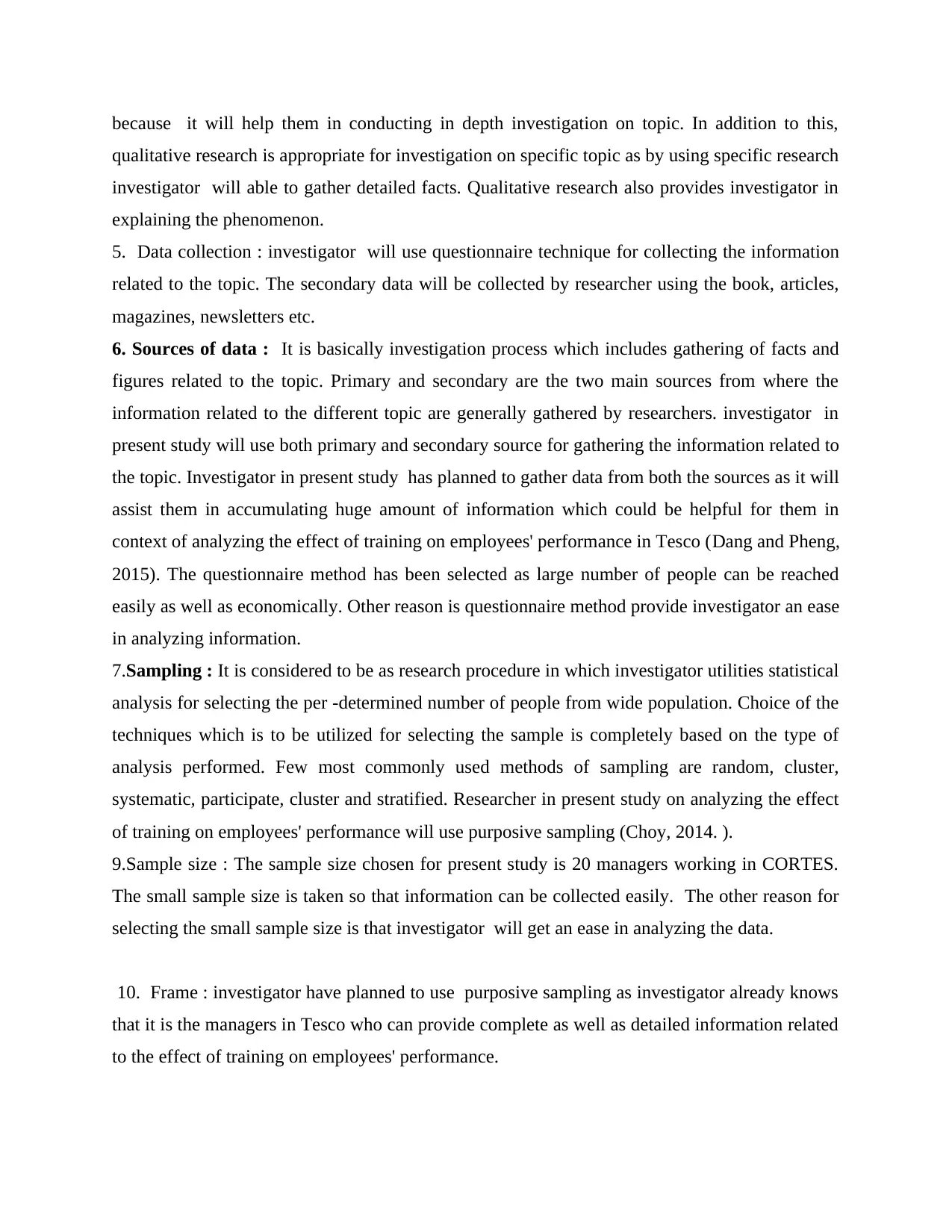
because it will help them in conducting in depth investigation on topic. In addition to this,
qualitative research is appropriate for investigation on specific topic as by using specific research
investigator will able to gather detailed facts. Qualitative research also provides investigator in
explaining the phenomenon.
5. Data collection : investigator will use questionnaire technique for collecting the information
related to the topic. The secondary data will be collected by researcher using the book, articles,
magazines, newsletters etc.
6. Sources of data : It is basically investigation process which includes gathering of facts and
figures related to the topic. Primary and secondary are the two main sources from where the
information related to the different topic are generally gathered by researchers. investigator in
present study will use both primary and secondary source for gathering the information related to
the topic. Investigator in present study has planned to gather data from both the sources as it will
assist them in accumulating huge amount of information which could be helpful for them in
context of analyzing the effect of training on employees' performance in Tesco (Dang and Pheng,
2015). The questionnaire method has been selected as large number of people can be reached
easily as well as economically. Other reason is questionnaire method provide investigator an ease
in analyzing information.
7.Sampling : It is considered to be as research procedure in which investigator utilities statistical
analysis for selecting the per -determined number of people from wide population. Choice of the
techniques which is to be utilized for selecting the sample is completely based on the type of
analysis performed. Few most commonly used methods of sampling are random, cluster,
systematic, participate, cluster and stratified. Researcher in present study on analyzing the effect
of training on employees' performance will use purposive sampling (Choy, 2014. ).
9.Sample size : The sample size chosen for present study is 20 managers working in CORTES.
The small sample size is taken so that information can be collected easily. The other reason for
selecting the small sample size is that investigator will get an ease in analyzing the data.
10. Frame : investigator have planned to use purposive sampling as investigator already knows
that it is the managers in Tesco who can provide complete as well as detailed information related
to the effect of training on employees' performance.
qualitative research is appropriate for investigation on specific topic as by using specific research
investigator will able to gather detailed facts. Qualitative research also provides investigator in
explaining the phenomenon.
5. Data collection : investigator will use questionnaire technique for collecting the information
related to the topic. The secondary data will be collected by researcher using the book, articles,
magazines, newsletters etc.
6. Sources of data : It is basically investigation process which includes gathering of facts and
figures related to the topic. Primary and secondary are the two main sources from where the
information related to the different topic are generally gathered by researchers. investigator in
present study will use both primary and secondary source for gathering the information related to
the topic. Investigator in present study has planned to gather data from both the sources as it will
assist them in accumulating huge amount of information which could be helpful for them in
context of analyzing the effect of training on employees' performance in Tesco (Dang and Pheng,
2015). The questionnaire method has been selected as large number of people can be reached
easily as well as economically. Other reason is questionnaire method provide investigator an ease
in analyzing information.
7.Sampling : It is considered to be as research procedure in which investigator utilities statistical
analysis for selecting the per -determined number of people from wide population. Choice of the
techniques which is to be utilized for selecting the sample is completely based on the type of
analysis performed. Few most commonly used methods of sampling are random, cluster,
systematic, participate, cluster and stratified. Researcher in present study on analyzing the effect
of training on employees' performance will use purposive sampling (Choy, 2014. ).
9.Sample size : The sample size chosen for present study is 20 managers working in CORTES.
The small sample size is taken so that information can be collected easily. The other reason for
selecting the small sample size is that investigator will get an ease in analyzing the data.
10. Frame : investigator have planned to use purposive sampling as investigator already knows
that it is the managers in Tesco who can provide complete as well as detailed information related
to the effect of training on employees' performance.
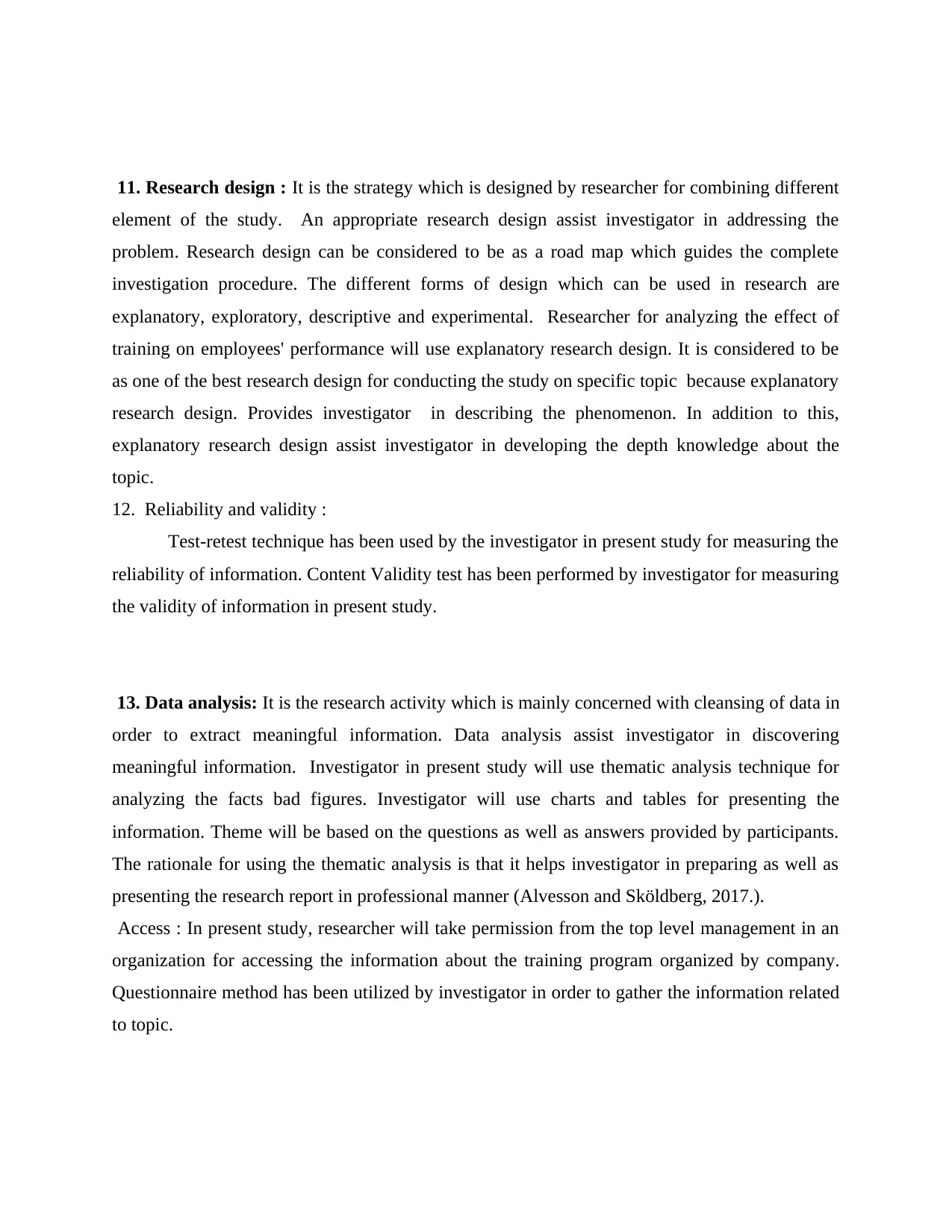
11. Research design : It is the strategy which is designed by researcher for combining different
element of the study. An appropriate research design assist investigator in addressing the
problem. Research design can be considered to be as a road map which guides the complete
investigation procedure. The different forms of design which can be used in research are
explanatory, exploratory, descriptive and experimental. Researcher for analyzing the effect of
training on employees' performance will use explanatory research design. It is considered to be
as one of the best research design for conducting the study on specific topic because explanatory
research design. Provides investigator in describing the phenomenon. In addition to this,
explanatory research design assist investigator in developing the depth knowledge about the
topic.
12. Reliability and validity :
Test-retest technique has been used by the investigator in present study for measuring the
reliability of information. Content Validity test has been performed by investigator for measuring
the validity of information in present study.
13. Data analysis: It is the research activity which is mainly concerned with cleansing of data in
order to extract meaningful information. Data analysis assist investigator in discovering
meaningful information. Investigator in present study will use thematic analysis technique for
analyzing the facts bad figures. Investigator will use charts and tables for presenting the
information. Theme will be based on the questions as well as answers provided by participants.
The rationale for using the thematic analysis is that it helps investigator in preparing as well as
presenting the research report in professional manner (Alvesson and Sköldberg, 2017.).
Access : In present study, researcher will take permission from the top level management in an
organization for accessing the information about the training program organized by company.
Questionnaire method has been utilized by investigator in order to gather the information related
to topic.
element of the study. An appropriate research design assist investigator in addressing the
problem. Research design can be considered to be as a road map which guides the complete
investigation procedure. The different forms of design which can be used in research are
explanatory, exploratory, descriptive and experimental. Researcher for analyzing the effect of
training on employees' performance will use explanatory research design. It is considered to be
as one of the best research design for conducting the study on specific topic because explanatory
research design. Provides investigator in describing the phenomenon. In addition to this,
explanatory research design assist investigator in developing the depth knowledge about the
topic.
12. Reliability and validity :
Test-retest technique has been used by the investigator in present study for measuring the
reliability of information. Content Validity test has been performed by investigator for measuring
the validity of information in present study.
13. Data analysis: It is the research activity which is mainly concerned with cleansing of data in
order to extract meaningful information. Data analysis assist investigator in discovering
meaningful information. Investigator in present study will use thematic analysis technique for
analyzing the facts bad figures. Investigator will use charts and tables for presenting the
information. Theme will be based on the questions as well as answers provided by participants.
The rationale for using the thematic analysis is that it helps investigator in preparing as well as
presenting the research report in professional manner (Alvesson and Sköldberg, 2017.).
Access : In present study, researcher will take permission from the top level management in an
organization for accessing the information about the training program organized by company.
Questionnaire method has been utilized by investigator in order to gather the information related
to topic.
⊘ This is a preview!⊘
Do you want full access?
Subscribe today to unlock all pages.

Trusted by 1+ million students worldwide
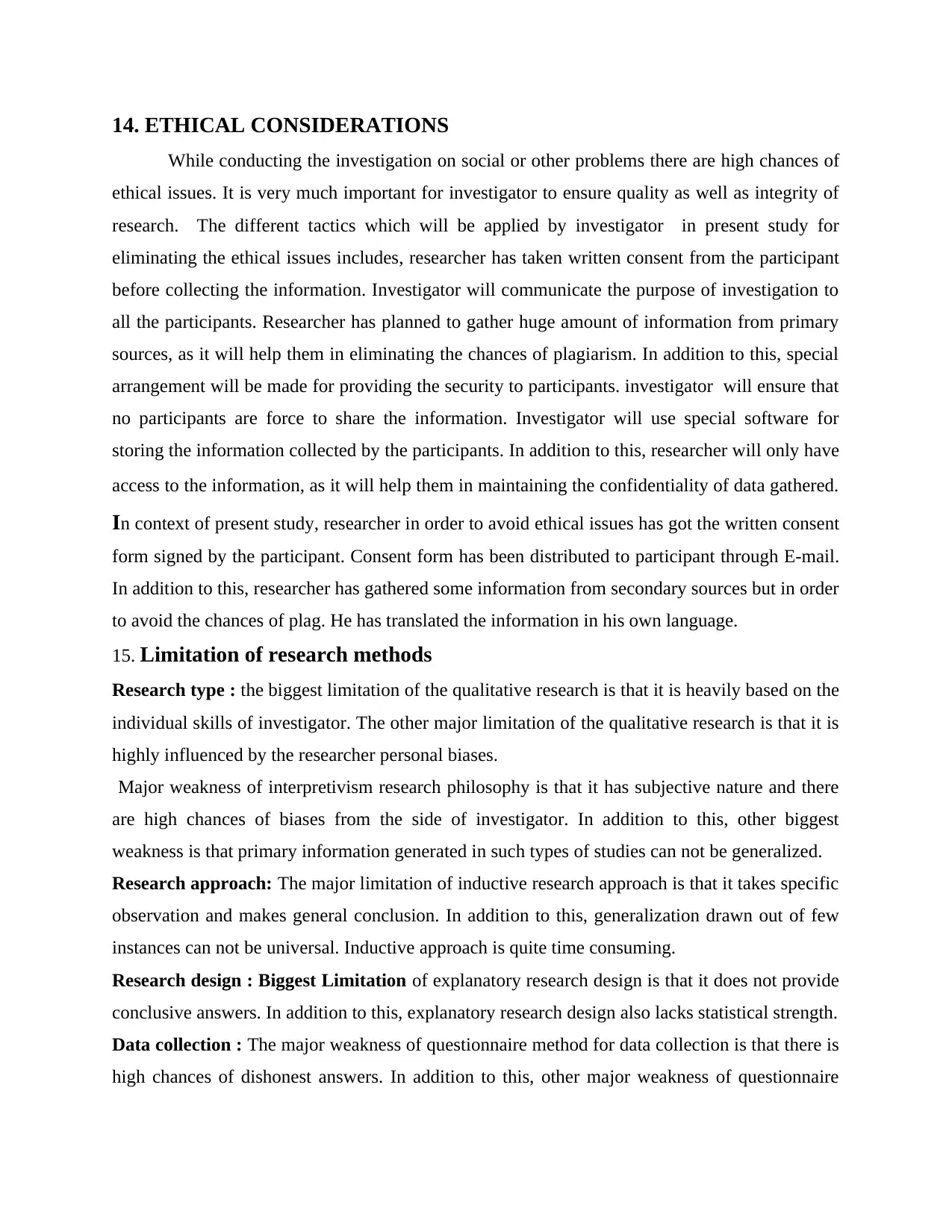
14. ETHICAL CONSIDERATIONS
While conducting the investigation on social or other problems there are high chances of
ethical issues. It is very much important for investigator to ensure quality as well as integrity of
research. The different tactics which will be applied by investigator in present study for
eliminating the ethical issues includes, researcher has taken written consent from the participant
before collecting the information. Investigator will communicate the purpose of investigation to
all the participants. Researcher has planned to gather huge amount of information from primary
sources, as it will help them in eliminating the chances of plagiarism. In addition to this, special
arrangement will be made for providing the security to participants. investigator will ensure that
no participants are force to share the information. Investigator will use special software for
storing the information collected by the participants. In addition to this, researcher will only have
access to the information, as it will help them in maintaining the confidentiality of data gathered.
In context of present study, researcher in order to avoid ethical issues has got the written consent
form signed by the participant. Consent form has been distributed to participant through E-mail.
In addition to this, researcher has gathered some information from secondary sources but in order
to avoid the chances of plag. He has translated the information in his own language.
15. Limitation of research methods
Research type : the biggest limitation of the qualitative research is that it is heavily based on the
individual skills of investigator. The other major limitation of the qualitative research is that it is
highly influenced by the researcher personal biases.
Major weakness of interpretivism research philosophy is that it has subjective nature and there
are high chances of biases from the side of investigator. In addition to this, other biggest
weakness is that primary information generated in such types of studies can not be generalized.
Research approach: The major limitation of inductive research approach is that it takes specific
observation and makes general conclusion. In addition to this, generalization drawn out of few
instances can not be universal. Inductive approach is quite time consuming.
Research design : Biggest Limitation of explanatory research design is that it does not provide
conclusive answers. In addition to this, explanatory research design also lacks statistical strength.
Data collection : The major weakness of questionnaire method for data collection is that there is
high chances of dishonest answers. In addition to this, other major weakness of questionnaire
While conducting the investigation on social or other problems there are high chances of
ethical issues. It is very much important for investigator to ensure quality as well as integrity of
research. The different tactics which will be applied by investigator in present study for
eliminating the ethical issues includes, researcher has taken written consent from the participant
before collecting the information. Investigator will communicate the purpose of investigation to
all the participants. Researcher has planned to gather huge amount of information from primary
sources, as it will help them in eliminating the chances of plagiarism. In addition to this, special
arrangement will be made for providing the security to participants. investigator will ensure that
no participants are force to share the information. Investigator will use special software for
storing the information collected by the participants. In addition to this, researcher will only have
access to the information, as it will help them in maintaining the confidentiality of data gathered.
In context of present study, researcher in order to avoid ethical issues has got the written consent
form signed by the participant. Consent form has been distributed to participant through E-mail.
In addition to this, researcher has gathered some information from secondary sources but in order
to avoid the chances of plag. He has translated the information in his own language.
15. Limitation of research methods
Research type : the biggest limitation of the qualitative research is that it is heavily based on the
individual skills of investigator. The other major limitation of the qualitative research is that it is
highly influenced by the researcher personal biases.
Major weakness of interpretivism research philosophy is that it has subjective nature and there
are high chances of biases from the side of investigator. In addition to this, other biggest
weakness is that primary information generated in such types of studies can not be generalized.
Research approach: The major limitation of inductive research approach is that it takes specific
observation and makes general conclusion. In addition to this, generalization drawn out of few
instances can not be universal. Inductive approach is quite time consuming.
Research design : Biggest Limitation of explanatory research design is that it does not provide
conclusive answers. In addition to this, explanatory research design also lacks statistical strength.
Data collection : The major weakness of questionnaire method for data collection is that there is
high chances of dishonest answers. In addition to this, other major weakness of questionnaire
Paraphrase This Document
Need a fresh take? Get an instant paraphrase of this document with our AI Paraphraser
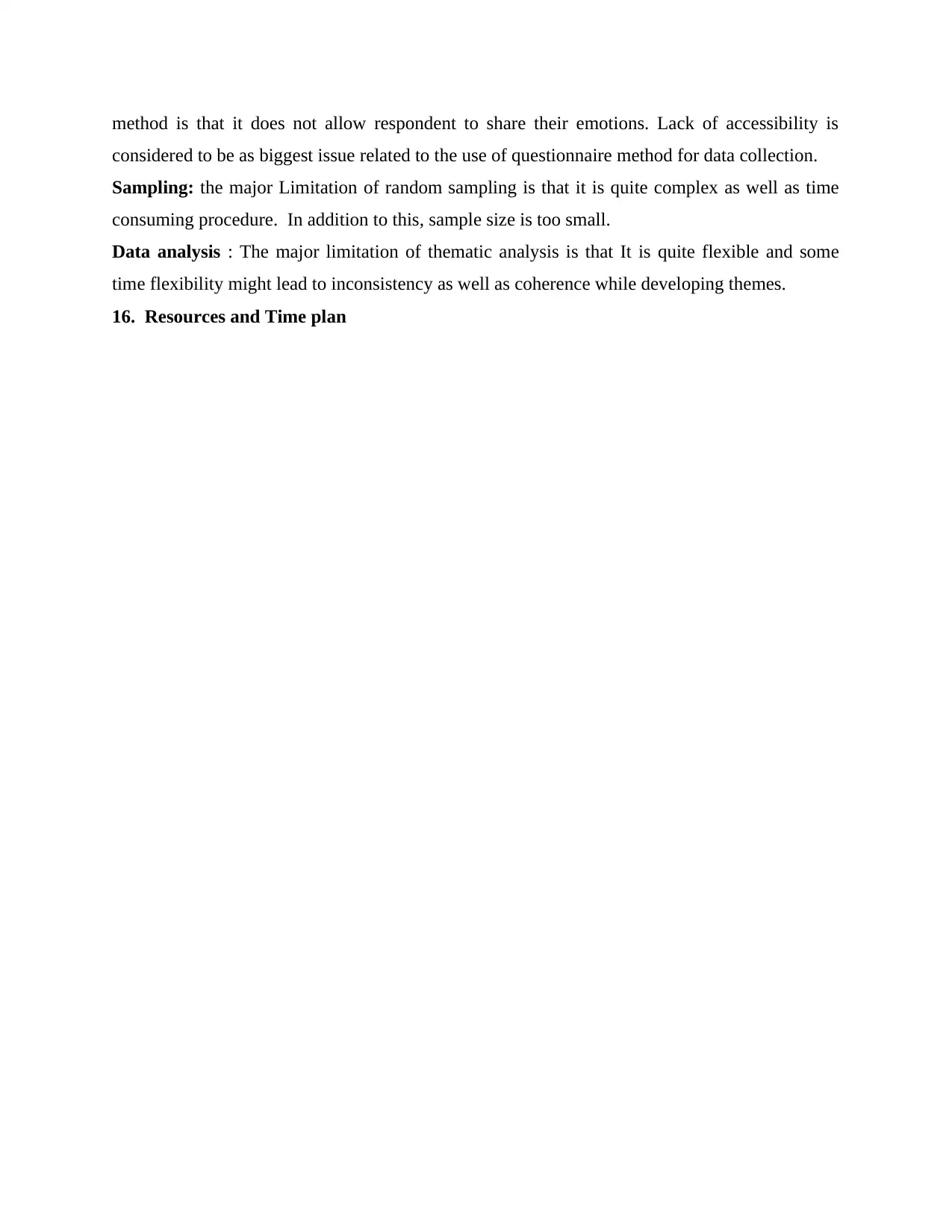
method is that it does not allow respondent to share their emotions. Lack of accessibility is
considered to be as biggest issue related to the use of questionnaire method for data collection.
Sampling: the major Limitation of random sampling is that it is quite complex as well as time
consuming procedure. In addition to this, sample size is too small.
Data analysis : The major limitation of thematic analysis is that It is quite flexible and some
time flexibility might lead to inconsistency as well as coherence while developing themes.
16. Resources and Time plan
considered to be as biggest issue related to the use of questionnaire method for data collection.
Sampling: the major Limitation of random sampling is that it is quite complex as well as time
consuming procedure. In addition to this, sample size is too small.
Data analysis : The major limitation of thematic analysis is that It is quite flexible and some
time flexibility might lead to inconsistency as well as coherence while developing themes.
16. Resources and Time plan
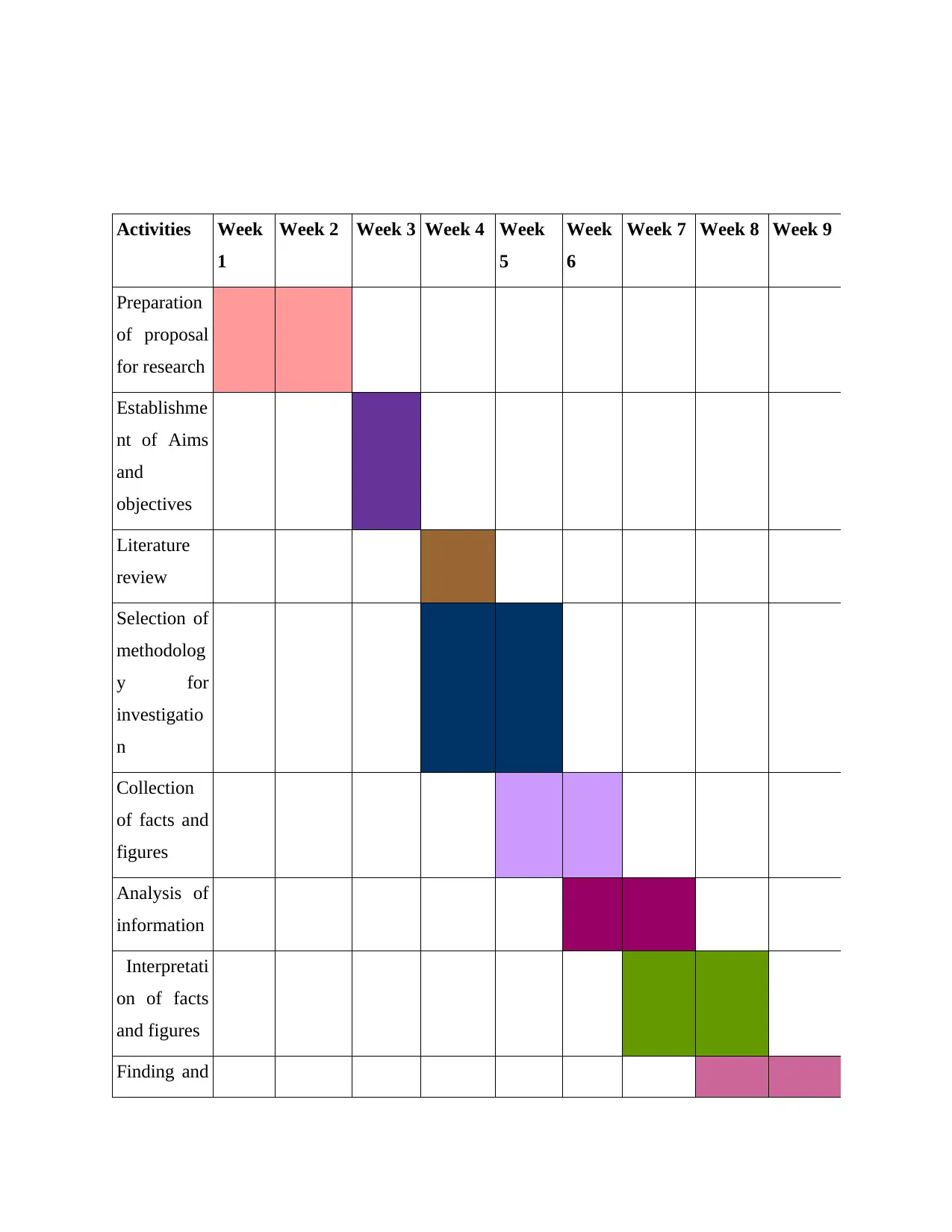
Activities Week
1
Week 2 Week 3 Week 4 Week
5
Week
6
Week 7 Week 8 Week 9
Preparation
of proposal
for research
Establishme
nt of Aims
and
objectives
Literature
review
Selection of
methodolog
y for
investigatio
n
Collection
of facts and
figures
Analysis of
information
Interpretati
on of facts
and figures
Finding and
1
Week 2 Week 3 Week 4 Week
5
Week
6
Week 7 Week 8 Week 9
Preparation
of proposal
for research
Establishme
nt of Aims
and
objectives
Literature
review
Selection of
methodolog
y for
investigatio
n
Collection
of facts and
figures
Analysis of
information
Interpretati
on of facts
and figures
Finding and
⊘ This is a preview!⊘
Do you want full access?
Subscribe today to unlock all pages.

Trusted by 1+ million students worldwide
1 out of 17
Related Documents
Your All-in-One AI-Powered Toolkit for Academic Success.
+13062052269
info@desklib.com
Available 24*7 on WhatsApp / Email
![[object Object]](/_next/static/media/star-bottom.7253800d.svg)
Unlock your academic potential
Copyright © 2020–2025 A2Z Services. All Rights Reserved. Developed and managed by ZUCOL.





